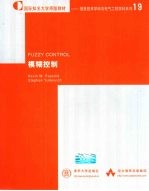图书介绍
模糊控制 英文本PDF|Epub|txt|kindle电子书版本网盘下载

- (美)KevinM.Passino,(美)StephenYurkovich著 著
- 出版社: 北京:清华大学出版社
- ISBN:7302049378
- 出版时间:2001
- 标注页数:478页
- 文件大小:25MB
- 文件页数:498页
- 主题词:
PDF下载
下载说明
模糊控制 英文本PDF格式电子书版下载
下载的文件为RAR压缩包。需要使用解压软件进行解压得到PDF格式图书。建议使用BT下载工具Free Download Manager进行下载,简称FDM(免费,没有广告,支持多平台)。本站资源全部打包为BT种子。所以需要使用专业的BT下载软件进行下载。如BitComet qBittorrent uTorrent等BT下载工具。迅雷目前由于本站不是热门资源。不推荐使用!后期资源热门了。安装了迅雷也可以迅雷进行下载!
(文件页数 要大于 标注页数,上中下等多册电子书除外)
注意:本站所有压缩包均有解压码: 点击下载压缩包解压工具
图书目录
CHAPTER 1 Introduction1
1.1 Overview1
1.2 Conventional Control System Design3
1.2.1 Mathematical Modeling3
1.2.2 Performance Objectives and Design Constraints5
1.2.3 Controller Design7
1.2.4 Performance Evaluation8
1.3 Fuzzy Control System Design9
1.3.1 Modeling Lssues and Performance Objectives11
1.3.2 Fuzzy Controller Design12
1.3.3 Performance Evaluation12
1.3.4 Application Areas13
1.4 What This Book Is About14
1.4.1 What the Techniques Are Good For:An Example14
1.4.2 Objectives of This Book16
1.5 Summary16
1.6 For Further Study17
1.7 Exercises18
CHAPTER 2 Fuzzy Control:The Basics21
2.1 Overview21
2.2 Fuzzy Control: A Tutorial Introduction22
2.2.1 Choosing Fuzzy Controller Inputs and Outputs23
2.2.2 Putting Control Knowledge into Rule-Bases25
2.2.3 Fuzzy Quantification of Knowledge30
2.2.4 Matching: Determining Which Rules to Use34
2.2.5 Inference Step:Determining Conclusions39
2.2.6 Converting Decisions into Actions41
2.2.7 Graphical Depiction of Fuzzy Decision Making46
2.2.8 Visualizing the Fuzzy Controller s Dynamical Operation47
2.3 General Fuzzy Systems48
2.3.1 Linguistic Variables, Values, and Rules49
2.3.2 Fuzzy Sets, Fuzzy Logic, and the Rule-Base52
2.3.3 Fuzzification57
2.3.4 The Inference Mechanism58
2.3.5 Defuzzification61
2.3.6 Mathematical Representations of Fuzzy Systems65
2.3.7 Takagi-Sugeno Fuzzy Systems69
2.3.8 Fuzzy Systems Are Universal Approximators72
2.4 Simple Design Example: The Inverted Pendulum73
2.4.1 Tuning via Scaling Universes of Discourse74
2.4.2 Tuning Membership Functions78
2.4.3 The Nonlinear Surface for the Fuzzy Controller81
2.4.4 Summary:Basic Design Guidelines84
2.5 Simulation of Fuzzy Control Systems85
2.5.1 Simulation of Nonlinear Systems85
2.5.2 Fuzzy Controller Arrays and Subroutines88
2.5.3 Fuzzy Controller Pseudocode89
2.6 Real-Time Implementation Issues91
2.6.1 Computation Time91
2.6.2 Memory Requirements92
2.7 Summary93
2.8 For Further Study95
2.9 Exercises95
2.10 Design Problems103
CHAPTER 3 Case Studies in Design and Implementation111
3.1 Overview111
3.2 Design Methodology113
3.3 Vibration Damping for a Flexible Robot115
3.3.1 The Two-Link Flexible Robot116
3.3.2 Uncoupled Direct Fuzzy Control120
3.3.3 Coupled Direct Fuzzy Control124
3.4 Balancing a Rotational Inverted Pendulum132
3.4.1 The Rotational Inverted Pendulum132
3.4.2 A Conventional Approach to Balancing Control135
3.4.3 Fuzzy Control for Balancing136
3.5 Machine Scheduling142
3.5.1 Conventional Scheduling Policies143
3.5.2 Fuzzy Scheduler for a Single Machine146
3.5.3 Fuzzy Versus Conventional Schedulers148
3.6 Fuzzy Decision-Making Systems151
3.6.1 Infectious Disease Warning System152
3.6.2 Failure Warning System for an Aircraft155
3.7 Summary158
3.8 For Further Study158
3.9 Exercises159
3.10 Design Problems161
CHAPTER 4 Nonlinear Analysls177
4.1 Overview177
4.2 Parameterized Fuzzy Controllers179
4.2.1 Proportional Fuzzy Controller180
4.2.2 Proportional-Derivative Fuzzy Controller182
4.3 Lyapunov Stability Analysis183
4.3.1 Mathematical Preliminaries183
4.3.2 Lyapunov s Direct Method184
4.3.3 Lyapunov s Indirect Method185
4.3.4 Example:Inverted Pendulum186
4.3.5 Example: The Parallel Distributed Compensator189
4.4 Absolute Stability and the Circle Criterion193
4.4.1 Analysis of Absolute Stability193
4.4.2 Example:Temperature Control197
4.5 Analysis of Steady-State Tracking Error199
4.5.1 Theory of Tracking Error for Nonlinear Systems199
4.5.2 Example: Hydrofoil Controller Design202
4.6 Describing Function Analysis202
4.6.1 Predicting the Existence and Stability of Llmit Cycles203
4.6.2 SISO Example: Underwater Vehicle Control System206
4.6.3 MISO Example: Tape Drive Servo206
4.7 Limitations of the Theory208
4.8 Summary210
4.9 For Further Study211
4.10 Exercises212
4.11 Design Problems215
CHAPTER 5 Fuzzy Identification and Estimation221
5.1 Overview221
5.2 Fitting Functions to Data223
5.2.1 The Function Approximation Problem223
5.2.2 Relation to Identification, Estimation, and Prediction226
5.2.3 Choosing the Data Set227
5.2.4 Incorporating Linguistic Information228
5.2.5 Case Study: Engine Failure Data Sets230
5.3 Least Squares Methods235
5.3.1 Batch Least Squares235
5.3.2 Recursive Least Squares239
5.3.3 Tuning Fuzzy Systems241
5.3.4 Example: Batch Least Squares Training of Fuzzy Systems244
5.3.5 Example: Recursive Least Squares Training of Fuzzy Systems245
5.4 Gradient Methods246
5.4.1 Training Standard Fuzzy Systems247
5.4.2 Implementation Issues and Example250
5.4.3 Training Takagi-Sugeno Fuzzy Systems252
5.4.4 Momentum Term and Step Size255
5.4.5 Newton and Gauss-Newton Methods256
5.5 Clustering Methods259
5.5.1 Clustering with Optimal Output Predefuzzification259
5.5.2 Nearest Neighborhood Clustering265
5.6 Extracting Rules from Data267
5.6.1 Learning from Examples(LFE)267
5.6.2 Modified Learning from Examples(MLFE)271
5.7 Hybrid Methods275
5.8 Case Study: FDI for an Engine277
5.8.1 Experimental Engine and Testing Conditions277
5.8.2 Fuzzy Estimator Construction and Results279
5.8.3 Failure Detection and Identification(FDI)Strategy281
5.9 Summary286
1.10 For Further Study287
5.11 Exercises287
5.12 Design Problems295
CHAPTER 6 Adaptive Fuzzy Control301
6.1 Overview301
6.2 Fuzzy Model Reference Learning Control(FMRLC)303
6.2.1 The Fuzzy Controller305
6.2.2 The Reference Model308
6.2.3 The Learning Mechanism309
6.2.4 Alternative Knowledge-Base Modifiers312
6.2.5 Design Guidelines for the Fuzzy Inverse Model314
6.3 FMRLC: Design and Implementation Case Studies316
6.3.1 Cargo Ship Steering316
6.3.2 Fault-Tolerant Aircraft Control329
6.3.3 Vibration Damping for a Flexible Robot339
6.4 Dynamically Focused Learning(DFL)345
6.4.1 Magnetic Ball Suspension System: Motivation for DFL346
6.4.2 Auto-Tuning Mechanism358
6.4.3 Auto-Attentive Mechanism361
6.4.4 Auto-Attentive Mechanism with Memory364
6.5 DFL:Design and Implementation Case Studies368
6.5.1 Rotational Inverted Pendulum369
6.5.2 Adaptive Machine Scheduling370
6.6 Indirect Adaptive Fuzzy Control374
6.6.1 On-Line Identification Methods374
6.6.2 Adaptive Control for Feedback Linearizable Systems375
6.6.3 Adaptive Parallel Distributed Compensation377
6.6.4 Example: Level Control in a Surge Tank378
6.7 Summary382
6.8 For Further Study384
6.9 Exercises385
6.10 Design Problems387
CHAPTER 7 Fuzzy Supervlsory Control391
7.1 Overview391
7.2 Supervision of Conventional Controllers393
7.2.1 Fuzzy Tuning of PID Controllers393
7.2.2 Fuzzy Gain Scheduling395
7.2.3 Fuzzy Supervision of Conventional Controllers398
7.3 Supervision of Fuzzy Controllers399
7.3.1 Rule-Base Supervision399
7.3.2 Case Study: Vibration Damping for a Flexible Robot400
7.3.3 Supervised Fuzzy Learning Control404
7.3.4 Case Study: Fault-Tolerant Aircraft Control405
7.4 Summary412
7.5 For Further Study413
7.6 Design Problems413
CHAPTER 8 Perspectives on Fuzzy Control415
8.1 Overview415
8.2 Fuzzy Versus Conventional Control416
8.2.1 Modeling Issues and Design Methodology416
8.2.2 Stability and Performance Analysis418
8.2.3 Implementation and General Issues419
8.3 Neural Networks419
8.3.1 Multilayer Perceptrons420
8.3.2 Radial Basis Function Neural Networks423
8.3.3 Relationships Between Fuzzy Systems and Neural Networks424
8.4 Genetic Algorithms426
8.4.1 Genetic Algorithms: A Tutorial427
8.4.2 Genetic Algorithms for Fuzzy System Design and Tuning433
8.5 Knowledge-Based Systems436
8.5.1 Expert Control436
8.5.2 Planning Systems for Control437
8.6 Intelligent and Autonomous Control438
8.6.1 What Is Intelligent Control ?439
8.6.2 Architecture and Characteristics440
8.6.3 Autonomy441
8.6.4 Example: Intelligent Vehicle and Highway Systems442
8.7 Summary445
8.8 For Further Study446
8.9 Exercises446
BIBLIOGRAPHY451
INDEX468